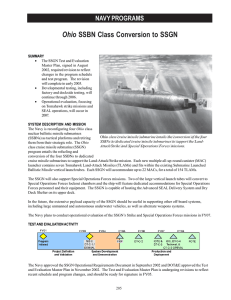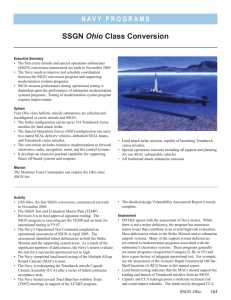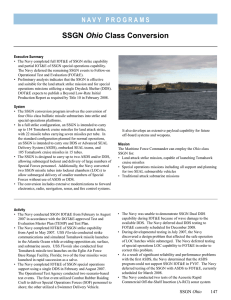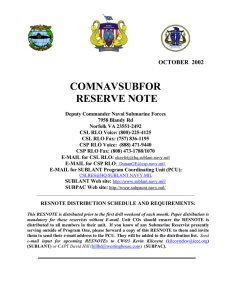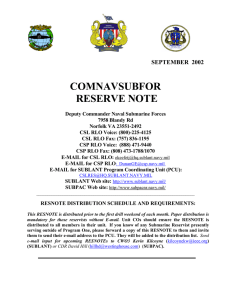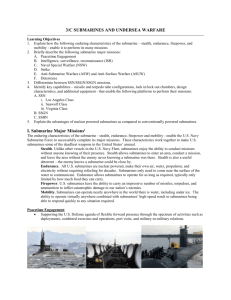Ohio n A V Y P r o G...
advertisement
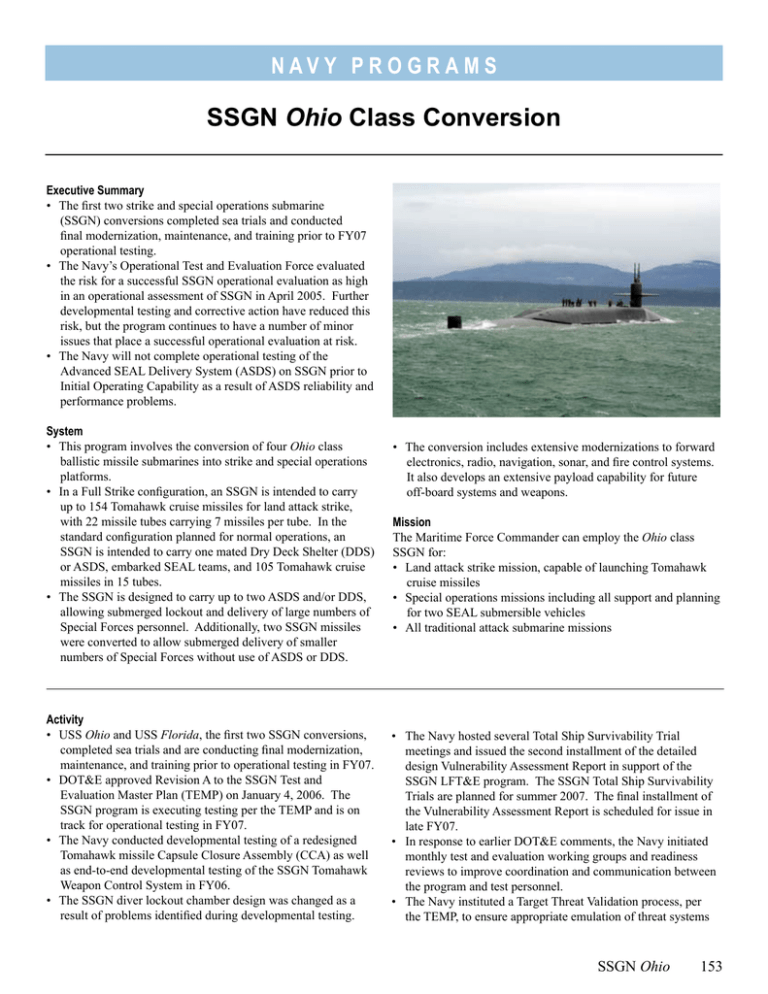
Navy P RO G R A M S SSGN Ohio Class Conversion Executive Summary • The first two strike and special operations submarine (SSGN) conversions completed sea trials and conducted final modernization, maintenance, and training prior to FY07 operational testing. • The Navy’s Operational Test and Evaluation Force evaluated the risk for a successful SSGN operational evaluation as high in an operational assessment of SSGN in April 2005. Further developmental testing and corrective action have reduced this risk, but the program continues to have a number of minor issues that place a successful operational evaluation at risk. • The Navy will not complete operational testing of the Advanced SEAL Delivery System (ASDS) on SSGN prior to Initial Operating Capability as a result of ASDS reliability and performance problems. System • This program involves the conversion of four Ohio class ballistic missile submarines into strike and special operations platforms. • In a Full Strike configuration, an SSGN is intended to carry up to 154 Tomahawk cruise missiles for land attack strike, with 22 missile tubes carrying 7 missiles per tube. In the standard configuration planned for normal operations, an SSGN is intended to carry one mated Dry Deck Shelter (DDS) or ASDS, embarked SEAL teams, and 105 Tomahawk cruise missiles in 15 tubes. • The SSGN is designed to carry up to two ASDS and/or DDS, allowing submerged lockout and delivery of large numbers of Special Forces personnel. Additionally, two SSGN missiles were converted to allow submerged delivery of smaller numbers of Special Forces without use of ASDS or DDS. Activity • USS Ohio and USS Florida, the first two SSGN conversions, completed sea trials and are conducting final modernization, maintenance, and training prior to operational testing in FY07. • DOT&E approved Revision A to the SSGN Test and Evaluation Master Plan (TEMP) on January 4, 2006. The SSGN program is executing testing per the TEMP and is on track for operational testing in FY07. • The Navy conducted developmental testing of a redesigned Tomahawk missile Capsule Closure Assembly (CCA) as well as end-to-end developmental testing of the SSGN Tomahawk Weapon Control System in FY06. • The SSGN diver lockout chamber design was changed as a result of problems identified during developmental testing. • The conversion includes extensive modernizations to forward electronics, radio, navigation, sonar, and fire control systems. It also develops an extensive payload capability for future off-board systems and weapons. Mission The Maritime Force Commander can employ the Ohio class SSGN for: • Land attack strike mission, capable of launching Tomahawk cruise missiles • Special operations missions including all support and planning for two SEAL submersible vehicles • All traditional attack submarine missions • The Navy hosted several Total Ship Survivability Trial meetings and issued the second installment of the detailed design Vulnerability Assessment Report in support of the SSGN LFT&E program. The SSGN Total Ship Survivability Trials are planned for summer 2007. The final installment of the Vulnerability Assessment Report is scheduled for issue in late FY07. • In response to earlier DOT&E comments, the Navy initiated monthly test and evaluation working groups and readiness reviews to improve coordination and communication between the program and test personnel. • The Navy instituted a Target Threat Validation process, per the TEMP, to ensure appropriate emulation of threat systems SSGN Ohio 153 Navy P RO G R A M S during operational evaluation and to provide a context for assessment. Assessment • As a result of the significant number of deficiencies identified during an April 2005 operational assessment, the Navy’s operational testers evaluated risk to a successful operational evaluation as high. Most deficiencies related to the Strike Mission and to submarine support systems. Many of these deficiencies have been addressed, but the program continues to have a number of minor issues that place a successful operational evaluation at risk. • Many of the remaining SSGN concerns are with the submarine’s electronics system modernization programs. Deficiencies in Acquisition Category II, III, or IV modernization programs, that have a poor history of adequate operational testing, can affect the ability of SSGN to complete her mission. For example, the Acoustic Rapid Commercial Off-the-Shelf Insertion (A-RCI) Sonar, assessed elsewhere in this annual report, is a concern. • Land- and sea-based testing of the SSGN Multiple All-Up-Round Canisters and modified Tomahawk Capsule Closure Assemblies indicate that these components should support the loading and launch of Tomahawk missiles from a SSGN. Acoustic and hydrodynamic trials were also satisfactory. • The Navy’s goal is to maintain the original ballistic missile submarine level of survivability by completing conversion to SSGN without introducing any new survivability deficiencies. Although they are likely to achieve this goal, DOT&E is concerned that the change in the submarine’s operational profile from an open ocean strategic mission to a littoral mission may introduce new susceptibilities. • As a result of significant reliability and performance problems with the first ASDS, the Navy determined that the ASDS 154 SSGN Ohio program cannot support operational testing on SSGN in FY07. This delay will significantly reduce SSGN special operations capability, although the remaining capability is expected to provide a significant improvement over existing platforms. DOT&E is working with the Navy to determine a realistic schedule for completion of ASDS developmental and operational testing, with the goal of completing as much as possible prior to SSGN Initial Operating Capability in early FY08. • The Navy’s SSGN Program Office is coordinating the schedules of the conversion and modernization programs. The time allocated for testing, repairing, and retesting of some modernization system programs is often shorter than will be required, based on previous experience. Recommendations • Status of Previous Recommendations. The Navy has taken effective action on two of the three previous DOT&E recommendations, but the following recommendation requires further attention: FY05 #1: The Navy improved coordination between the SSGN conversion program and submarine modernization programs as recommended by DOT&E. However, the Navy must ensure full operational testing of submarine modernization programs installed on SSGN. The operational test of the SSGN, in each mission area, is designed to be an end-to-end test. SSGN mission-area performance cannot reasonably be separated from the performance of submarine modernization systems that contribute to the mission area. • FY06 Recommendation. 1. The Navy should aggressively pursue developmental and operational testing of ASDS on SSGN as soon as practicable.
